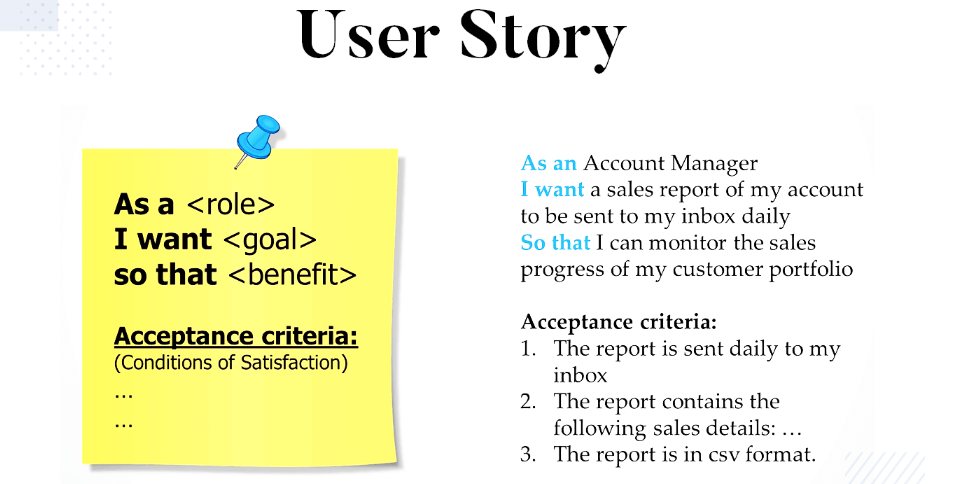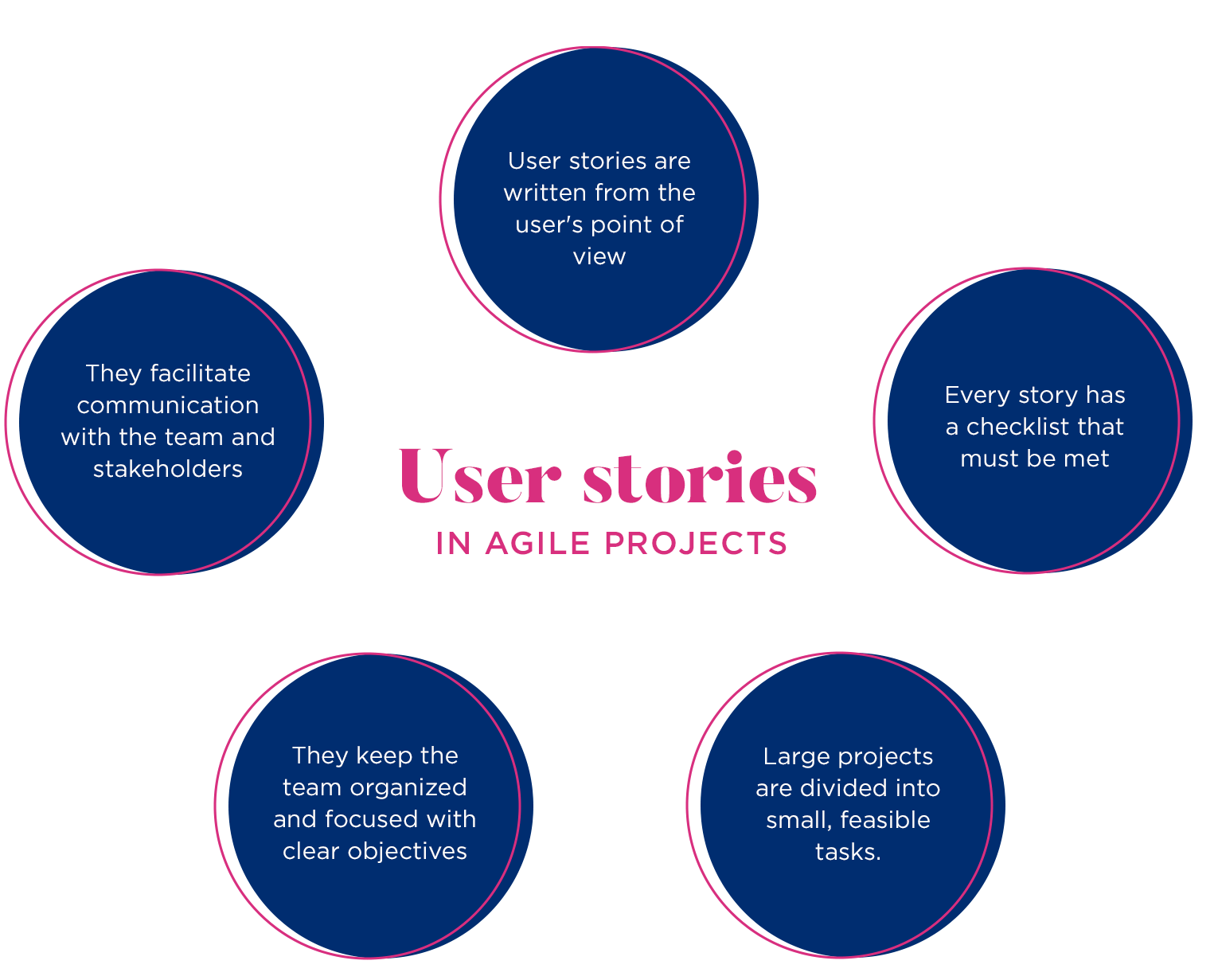Definition of User Stories
In software development and product management, a user story is an informal, natural-language description of a software system’s functionality, written from the perspective of the end-user or system stakeholder. User stories can be documented on physical index cards, sticky notes, or digitally stored in specialized management software. They may be created by various stakeholders depending on the project, including customers, end-users, product managers, or developers.
User stories act as boundary objects, promoting shared understanding among stakeholders and facilitating communication. They help development teams articulate their collective understanding of the system and its context.

Historical Development
- 1997: Kent Beck introduced the concept of user stories at Chrysler’s C3 project in Detroit.
- 1998: Alistair Cockburn, visiting the C3 project, described user stories as “promises for conversation.”
- 1999: Kent Beck published the first edition of “Extreme Programming Explained,” describing how user stories are used in XP’s Planning Game.
- 2001: Ron Jeffries formulated the “Three Cs” for user stories:
- Card: A tangible token, typically an index card or sticky note.
- Conversation: A collaborative dialogue among stakeholders (customers, users, developers, testers).
- Confirmation: Criteria agreed upon by stakeholders to confirm story completion.
- 2001: The XP team at Connextra (London) designed and popularized the commonly used user story template.
- 2004: Mike Cohn published “User Stories Applied: For Agile Software Development,” which became a foundational reference. Martin Fowler considers this book a standard reference on the topic. Mike Cohn credits Rachel Davies with originating user stories.
- 2014: Jeff Patton introduced User Story Mapping, a systematic method to visualize and structure user stories, clarifying their relationships and dependencies.
Core Principles of User Stories: INVEST
Effective user stories follow the INVEST principles:
- Independent: User stories should be as independent as possible from each other to simplify planning, prioritization, and estimation. Dependencies can usually be minimized by splitting or combining stories.
- Negotiable: Stories are placeholders for conversations, not detailed contracts. Too much upfront detail limits meaningful communication. The necessary details emerge naturally during discussions.
- Valuable: Every user story must clearly deliver value to users or customers. Ideally, customers or end-users themselves should participate in writing or refining stories to ensure alignment with real needs.
- Estimable: Development teams should be able to estimate the effort required for a story. If estimation is challenging, it indicates a lack of clarity, insufficient domain knowledge, or that the story may be too large (necessitating further breakdown).
- Small: Good user stories are small enough (ideally 2-3 days of work) to be completed within a single iteration or sprint, thereby reducing complexity and risk.
- Testable: A user story must have clear acceptance criteria or test scenarios to confirm completion. Stories lacking explicit testable conditions (e.g., “the software should be easy to use”) are ambiguous and difficult to verify.
Common Formats for User Stories
Several templates are widely used:
- Connextra Template (most popular):
“As a [role], I want [capability], so that [I receive benefit].”
- Chris Matts’ value-oriented format:
“In order to <benefit>, as a <role>, I can <achieve goal/desire>.”
- The “Five Ws” format:
“As a <who>, <when/where>, I want <something> because <reason>.” - Misuse (Evil) Stories (primarily for security scenarios, reflecting attacker perspectives):
“As a disgruntled employee, I want to erase the user database to harm the company.”
Examples of User Stories:
- Screening Test (Epic)
“As an HR Manager, I want to create a screening test so that I can determine whether to forward suitable candidates to functional managers.” - Quiz Review
“As a hiring manager, I want to review existing quizzes so I can decide if they can be reused or updated for new positions.” - Limited Backups
“As a user, I want the option to exclude specific folders from backups to avoid filling my backup drive with unnecessary files.”
Usage in Agile Development
In Agile frameworks (such as Scrum and Extreme Programming), user stories are core to planning development efforts. The Product Owner or customer prioritizes user stories based on business value, while developers estimate their relative size (often using Fibonacci numbers) and break them down into tasks.
Detailed requirements often emerge as a story approaches implementation, captured through stakeholder discussions, documentation, annotations, attachments, and acceptance criteria.
Acceptance Criteria
Mike Cohn defines acceptance criteria as “the conditions a story must satisfy to be accepted as complete by the Product Owner.” Acceptance criteria provide clear boundaries for verifying whether a user story fulfills intended functionality and quality.
Acceptance criteria are commonly presented as “Given–When–Then” scenarios or straightforward bullet-point statements drawn from stakeholder discussions. To be considered “done,” deliverables must satisfy all established acceptance criteria.
Relationship to Epics, Themes, and Initiatives
User stories can be grouped at different abstraction levels for clarity and management:
- Initiatives: High-level groupings of multiple themes or epics, usually aligning with strategic goals.
- Themes: Collections of related epics or large user stories, often spanning multiple iterations or releases.
- Epics: A collection of user stories logically related, usually too large to be completed within a single sprint and thus requiring further decomposition.
User Story Mapping
Developed by Jeff Patton, User Story Mapping is a visualization technique that organizes user stories into a coherent narrative, reducing the risk of losing track of product objectives amidst detailed, fragmented requirements. Story mapping starts with stakeholder workshops to identify key business activities. These activities become the horizontal backbone of the map. More detailed user stories are arranged vertically beneath these activities, ordered by priority or necessity.
The resulting two-dimensional visualization provides clarity about how stories relate to each other and to the overall product vision, aiding agile teams in maintaining focus on delivering real business value efficiently.
